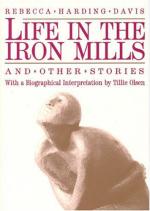
|
| Name: _________________________ | Period: ___________________ |
This test consists of 15 multiple choice questions and 5 short answer questions.
Multiple Choice Questions
1. Where does Deborah say Hugh was born in “Life in the Iron Mills”?
(a) The flat prairie
(b) The mountain crags
(c) The lane moor
(d) The Derbyshire
2. From whom did Deborah presumably steal the money in “Life in the Iron Mills”?
(a) Mr. Kirby
(b) Dr. May
(c) Mr. Mitchell
(d) Mr. Wolfe
3. When was Waiting for the Verdict published?
(a) 1898
(b) 1839
(c) 1811
(d) 1867
4. Rebecca Harding Davis is credited with over how many published works?
(a) 20
(b) 500
(c) 50
(d) 100
5. Who throws Deborah money as the visiting men at the mill depart in “Life in the Iron Mills”?
(a) Mr. Mitchell
(b) Mr. Kirby
(c) Mr. Clarke
(d) Mr. Wolfe
6. What Greek goddess of love and beauty does the narrator describe a sculpture of in “Life in the Iron Mills”?
(a) Echo
(b) Achilles
(c) Aphrodite
(d) Athena
7. What war caused Rebecca Harding Davis to set aside her writing for a time?
(a) The American Revolution
(b) The French and Indian War
(c) The U.S. Civil War
(d) The Korean War
8. How many children did Rebecca Harding Davis have?
(a) 3
(b) 7
(c) 2
(d) 1
9. The church that Hugh enters on the night he decides to keep the money is described by the narrator of “Life in the Iron Mills” as what?
(a) An epic cathedral
(b) A Gregorian haunt
(c) A somber Gothic pile
(d) A medieval rapture
10. Whom does Deborah feel a pang of jealousy about as she lay on the ash heap at Hugh’s job in “Life in the Iron Mills”?
(a) Mr. Mitchell
(b) Old Wolfe
(c) Sarah
(d) Janey
11. What is the mill-owner’s son’s reply in French when Dr. May asks him, “Have you many such hands as this? What are you going to do with them? Keep them at puddling iron?”
(a) Ce n’est pas les bons temps
(b) Laissez les bons temps roules
(c) Ce n’est pas mon affaire
(d) Laissez faire
12. What Biblical figure, the son of Isaac, does the narrator denote having been deprived of his birthright in “Life in the Iron Mills”?
(a) Cain
(b) Peter
(c) Esau
(d) Abel
13. What is the name of the overseer that comes with the visiting men to the mill in “Life in the Iron Mills”?
(a) Mr. Clarke
(b) Mr. Wolfe
(c) Mr. Kirk
(d) Mr. Mitchell
14. Where does Deborah hide the money she’s stolen when Hugh falls asleep after they’ve arrived home from the mill in “Life in the Iron Mills”?
(a) In her jewelry box
(b) In Hugh’s pocket
(c) In the attic
(d) In her apron pocket
15. What does Hugh use to commit suicide in jail in “Life in the Iron Mills”?
(a) A police gun
(b) A piece of tin
(c) A bed sheet
(d) A rope
Short Answer Questions
1. What is the name of the man that goes about town lighting the lamps at dusk in “Life in the Iron Mills”?
2. On what date did Rebecca Harding Davis die?
3. The narrator in “Life in the Iron Mills” describes Hugh Wolfe as “A morbid, gloomy man, untaught, unled, left to feed his soul in” what?
4. Of Hugh Wolfe, the narrator says in “Life in the Iron Mills,” “His soul within him was smothering to death; he wanted so much, thought so much, and knew” what?
5. Of the sculpture discovered by the visitors at the iron mill in “Life in the Iron Mills,” the narrator says, “There was not one line of beauty or grace in it: a nude woman’s form, muscular, grown coarse with labor, the powerful limbs instinct with some one poignant” what?
|
This section contains 590 words (approx. 2 pages at 300 words per page) |

|




